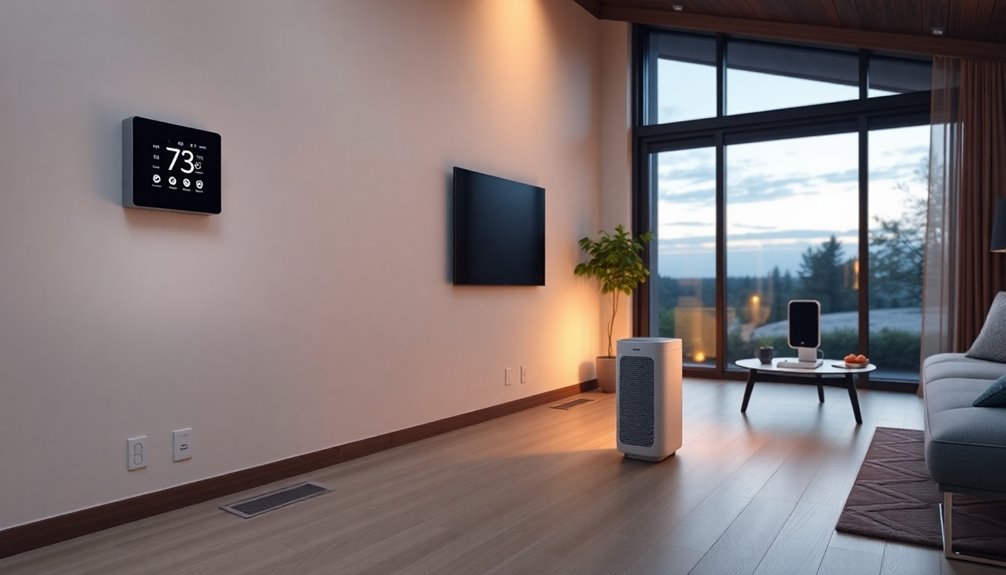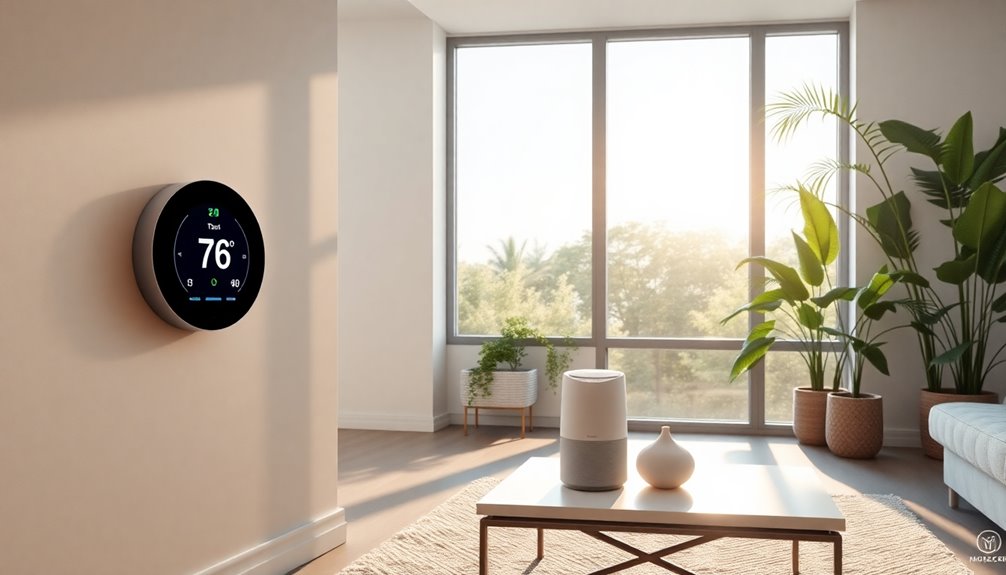I’ve found the 15 best smart home climate control devices that really enhance comfort and efficiency in any home. Devices like the Sensibo Sky and Honeywell Home T9 offer intelligent features such as occupancy detection and energy-efficient scheduling that can cut costs considerably. Smart thermostats, air conditioner controllers, and integrated systems provide centralized management, making it easy to enjoy ideal climates with just a touch. Plus, the user-friendly interfaces make controlling your environment a breeze. If you’re curious about which specific models to evaluate and what factors to weigh, there’s plenty more to uncover. In addition to these innovative products, it’s essential to monitor your indoor climate effectively, which is where the best indoor thermometers for home come into play. These devices provide accurate readings of temperature and humidity levels, allowing you to make informed adjustments to your climate control systems. By integrating reliable thermometers with your smart home setup, you can further enhance your home’s comfort and energy efficiency.
Key Takeaways
- Smart thermostats like Honeywell Home T9 offer energy-efficient features, reducing heating and cooling costs by up to 27% through intelligent scheduling.
- Air conditioner controllers such as Sensibo Sky and Breez Plus enhance energy efficiency, potentially lowering cooling bills by up to 40%.
- Reliable climate monitoring sensors from brands like Sensirion provide accurate readings and integrate with smart hubs for comprehensive climate control.
- Centralized control solutions like Brilliant Smart Home Control allow users to manage various smart devices easily through intuitive interfaces.
- Remote control capabilities and programmable scheduling features enable significant energy savings while maintaining optimal comfort levels in homes.
Sensibo Sky Smart Wireless Air Conditioner Controller
If you're looking to enhance your home's comfort and save on energy bills, the Sensibo Sky Smart Wireless Air Conditioner Controller is a fantastic choice. This sleek device measures just 3.2" x 2.2" and weighs only 2.4 ounces, making installation a breeze. It works with various AC types, including window units and heat pumps, and it's capable of reducing cooling bills by up to 40%. I love the geofencing feature that activates the AC before I arrive home, ensuring I'm greeted with a comfortable environment. Plus, I can control everything via the mobile app or voice commands with Alexa or Google Assistant. With its 7-day programming, I can customize settings for each room, adding to my home's efficiency and comfort.
Best For: Those looking to efficiently control their air conditioning systems and reduce energy costs while enjoying smart home features.
Pros:
- Energy Efficient: Reduces cooling bills by up to 40%, making it a cost-effective solution.
- Smart Features: Offers geofencing, climate monitoring, and 7-day programming for optimal comfort.
- Voice Control: Compatible with major voice assistants like Amazon Alexa and Google Assistant for convenient operation.
Cons:
- Not Bluetooth Compatible: Lacks Bluetooth functionality, which may limit some users' preferences for connectivity.
- Installation Required: Although installation is described as easy, it still requires wall mounting and setup.
- Limited to Specific AC Types: Only compatible with certain models of air conditioners, which may exclude some users.
ecobee Smart Sensor 2 Pack for Smart Home
The ecobee Smart Sensor 2 Pack is a game-changer for anyone looking to enhance their home's climate control. By communicating temperature data to your ecobee smart thermostat from up to 60 feet away, these sensors guarantee your home feels comfortable no matter where you are. They effectively reduce energy use by monitoring room occupancy, so you won't waste heating or cooling in empty spaces. I love how easy they are to install—just place them above five feet high using the included magnetic stands or adhesive brackets. Plus, with real-time alerts for unexpected motion, they add a layer of security. For me, the investment is worth it for the comfort and energy savings these sensors provide.
Best For: Those seeking to optimize home climate control and enhance energy efficiency while enjoying added security features.
Pros:
- Easy installation with versatile mounting options (magnetic stands or adhesive brackets).
- Improves temperature regulation across rooms, especially in homes with challenging layouts.
- Provides real-time alerts for unexpected motion, enhancing home security.
Cons:
- Some users feel the price is high for two sensors, leading to potential buyer's remorse.
- Requires a subscription for full Smart Security features and alerts.
- May not be as effective in larger homes due to maximum range limitations.
Breez Plus Smart Air Conditioner Controller
Looking to optimize your home's climate control? The Breez Plus Smart Air Conditioner Controller could be your solution. This device connects to your mini-split, portable, or window AC units via IR remote, allowing you to control everything from your smartphone, Alexa, or Google Home. I love that it reduces my energy bills by up to 25% while providing inbuilt temperature and humidity sensors. The easy setup and intuitive app make managing my settings a breeze, and I appreciate the weekly scheduling and location-based controls. Plus, with a customer satisfaction rating of 4.6 out of 5, it's hard not to be impressed. Overall, the Breez Plus offers a reliable, user-friendly way to enhance your home's climate control.
Best For: Homeowners looking to enhance their climate control and reduce energy costs with smart technology.
Pros:
- Energy Savings: Reduces AC energy bills by up to 25%.
- User-Friendly: Easy setup with an intuitive app for managing settings.
- Smart Automation: Offers weekly scheduling and location-based controls for convenience.
Cons:
- Initial Confusion: Some users may experience confusion with Comfy Mode settings.
- Price Concerns: A few customers have noted that the price may be on the higher side.
- Shipping Delays: Some users reported delays in shipping their devices.
Aqara Smart Hub M3 for Home Automation
For anyone seeking seamless integration of various smart home devices, the Aqara Smart Hub M3 is an excellent choice. This versatile hub supports multiple protocols like Zigbee, Bluetooth, and Wi-Fi, making it compatible with popular platforms like Alexa and Apple HomeKit. I appreciate its dual-band Wi-Fi and local automation capabilities, which enhance connectivity and security. The 360° IR blaster is a game-changer, allowing me to connect my air conditioning unit and control it effortlessly. Plus, with 8GB of encrypted storage, I can keep my device configurations private. Although some users mention range issues, my experience has been positive, and I'm optimistic about future updates enhancing its capabilities even further.
Best For: Users looking for a versatile smart home hub that integrates multiple protocols and platforms for seamless home automation.
Pros:
- Supports multiple protocols including Zigbee, Bluetooth, and Wi-Fi, ensuring compatibility with a wide range of devices.
- Local automation capabilities provide enhanced security and reliability, reducing dependence on cloud services.
- 360° IR blaster allows for easy control of IR devices like air conditioning units, enhancing functionality.
Cons:
- Range limitations of 60-65 feet may affect connectivity for larger homes or setups.
- Migration issues from older Aqara hubs to the M3 may require additional reconfiguration efforts.
- Current integration with third-party devices is limited, potentially restricting user options for some smart home setups.
VENZ Smart Air Conditioner Controller (WiFi Thermostat for Home)
Transforming your traditional air conditioner into a smart unit, the VENZ Smart Air Conditioner Controller is perfect for anyone seeking enhanced energy efficiency and convenience. This WiFi thermostat works seamlessly with mini splits, portable, and window air conditioners, plus heat pumps. I love that it offers remote and voice control through Alexa and Google Assistant, allowing me to adjust settings effortlessly.
With its built-in temperature and humidity sensor, I can monitor real-time conditions. The 7-day programming feature tailors my climate preferences to my schedule, while geo-fencing guarantees my devices respond to my location. Plus, the easy setup and IR learning function make it compatible with nearly any remote-controlled device. It's a game-changer for my home comfort!
Best For: Those looking to upgrade their traditional air conditioning system to a smart, energy-efficient solution that offers remote and voice control.
Pros:
- Energy Efficiency: Enhances the energy efficiency of traditional air conditioners, potentially lowering energy bills.
- Versatile Compatibility: Works with various types of air conditioning units, including mini splits, portable, and window units.
- Smart Features: Offers advanced features like geo-fencing and 7-day programming for customized climate control.
Cons:
- Moderate Customer Ratings: With a rating of 3.5 out of 5 stars, some users may find issues or limitations.
- WiFi Dependency: Requires a stable 2.4GHz WiFi connection for optimal functionality.
- Learning Curve: The setup and programming may be challenging for users who are not tech-savvy.
Aqara Temperature and Humidity Sensor (3 Pack)
The Aqara Temperature and Humidity Sensor (3 Pack) is an excellent choice for anyone wanting to enhance their smart home experience with reliable climate monitoring. These sensors connect seamlessly through the Aqara Hub, allowing you to track temperature and humidity levels effortlessly. They've got a wide measurement range and send push alerts if thresholds are crossed, which means I can automate my fans or humidifiers without lifting a finger. I appreciate their compact design and waterproof feature, making them versatile for any room. With an average rating of 4.2 stars and a 1-year warranty, I feel confident in my purchase. Plus, the included batteries guarantee I'm up and running right away. Overall, these sensors elevate my home's comfort and efficiency!
Best For: Individuals looking to improve their smart home setup with reliable temperature and humidity monitoring.
Pros:
- Easy integration with Aqara Hub and compatibility with Apple HomeKit, Alexa, and IFTTT.
- Accurate measurements using high-quality sensors from Sensirion.
- Waterproof and compact design allows for versatile placement in any room.
Cons:
- Difficulty pairing with non-Aqara hubs, such as SmartThings.
- Some users experienced dead sensors or battery issues upon arrival.
- Occasional disconnections that may require re-pairing.
Brilliant Smart Home Control with Alexa Built-In
With its built-in Alexa integration, the Brilliant Smart Home Control is perfect for anyone who wants seamless voice control over their smart devices. I love how it flush mounts to any wall and plugs into an outlet without needing a neutral wire, making installation a breeze. The 5-inch LCD touchscreen is not only visually appealing but also functional, allowing me to control lighting, music, and even my Ring Video Doorbell effortlessly. While the voice control is convenient, I've noticed some users report a clunky interface and connectivity issues. Nonetheless, the ability to manage multiple smart devices in one place is still a huge advantage. Just keep in mind the potential for obsolescence, as newer integrations may not come.
Best For: Those seeking an easy-to-install smart home control solution with Alexa integration for managing multiple devices seamlessly.
Pros:
- Built-in Alexa enables hands-free voice control for a variety of smart devices.
- Flush mounts easily to any wall and plugs into an outlet without requiring a neutral wire.
- 5-inch LCD touchscreen provides intuitive control over lighting, music, and other smart home functionalities.
Cons:
- Some users report a clunky interface and connectivity issues with certain devices.
- The 10-foot cord length can be difficult to hide and may not suit all installation preferences.
- Concerns about potential obsolescence due to limited new integrations and support from the company.
WiFi Smart Remote Controller for Smart Home Devices
Looking for a seamless way to control your home appliances? The WiFi Smart Remote Controller is a game-changer for managing devices like your TV, AC, and fans—all from one app. It supports over 50,000 devices and lets me add more using existing remotes. I love that it integrates with Alexa and Google Home for hands-free control.
Using the Tuya or Smart Life app, I can manage my appliances from anywhere, set timers, and create custom scenes. The setup is straightforward, and I've found it easy to clone IR buttons for personalized commands. While I've faced a few hiccups with voice control and connectivity, the overall experience has been positive, especially with responsive customer support.
Best For: Individuals seeking a convenient and centralized solution to control multiple smart home devices from a single app.
Pros:
- Supports over 50,000 devices, allowing for extensive compatibility with various household appliances.
- Easy setup process with the ability to clone IR buttons for customized control.
- Integrates seamlessly with popular voice assistants like Alexa and Google Home for hands-free operation.
Cons:
- Voice control may not recognize certain devices, limiting functionality with Google Home.
- Power toggle commands can lead to unintended device states, causing confusion.
- Some users encounter connectivity issues with Alexa, affecting reliability and performance.
Smart Thermostat with App Control and Geofencing
For busy professionals and frequent travelers, a smart thermostat with app control and geofencing proves invaluable. The Degrii smart thermostat, for instance, can cut heating and cooling costs by up to 27% through intelligent scheduling. With its compatibility across 95% of HVAC systems, installation takes only about 15 minutes, thanks to the user-friendly Degrii OS app. I love being able to manage home temperatures remotely, and the geofencing feature adjusts settings when I'm nearby, ensuring comfort when I return. Plus, the built-in child lock adds a layer of safety. Although some users have faced app interface challenges, the overall performance and energy savings make it a worthy investment for anyone seeking efficiency in their home climate control.
Best For: Busy professionals and frequent travelers seeking efficient and customizable home climate control.
Pros:
- Up to 27% reduction in heating and cooling costs through intelligent scheduling.
- Quick DIY installation in approximately 15 minutes with the help of the user-friendly app.
- Remote management and geofencing technology ensures comfort upon arrival home.
Cons:
- Some users report difficulties with the app's interface and limited scheduling options.
- Concerns about the LCD timing out and limited dimming options.
- Feedback indicates a desire for more advanced features like fan circulation options.
Mysa Smart Thermostat for Mini-Split Heat Pumps & AC
The Mysa Smart Thermostat is perfect for anyone managing ductless mini-split heat pumps or portable AC units. It replaces traditional remote controls, allowing you to monitor and adjust your climate settings effortlessly through a free app—no subscription fees needed. I love its sleek Canadian design and the fact it works with HomeKit, Alexa, and Google Home for voice control.
With features like in-app schedules, geofencing, and Climate+, it helps me save on electricity bills while providing smart alerts for comfort and safety. Setting it up was a breeze, thanks to step-by-step video guidance. However, while many users rave about its reliability, I've noticed some occasional quirks with automation. Overall, it's a fantastic addition to my smart home setup.
Best For: The Mysa Smart Thermostat is best for homeowners with ductless mini-split heat pumps or portable AC units looking for smart, efficient climate control.
Pros:
- Smart home integration with HomeKit, Alexa, and Google Home for easy voice control.
- Energy-saving features like geofencing and in-app schedules help reduce electricity bills.
- User-friendly setup with step-by-step video guidance and expert support available.
Cons:
- Some users experience occasional issues with automation and routine settings.
- Temperature settings may revert unexpectedly at times.
- Average customer rating of 3.7 stars indicates mixed feedback on reliability.
Brilliant Smart Home Control with Alexa Built-In (1-Switch Panel)
Brilliant Smart Home Control with Alexa Built-In (1-Switch Panel) is an excellent choice for anyone seeking a sleek, all-in-one device to manage their smart home environment effortlessly. With its in-wall touchscreen, I can easily control lights, music, and more from one central location. The compatibility with various devices like Ring, Sonos, and Google Nest makes it versatile, although I've noticed some limitations with device recognition, particularly with SmartThings. Installation is pretty straightforward, but I had to use the Brilliant app for setup, which can be a hassle for international users. The interface is visually appealing, displaying time and weather, but I hope for more integration options in the future to enhance my experience further.
Best For: Individuals looking for a centralized smart home control solution that integrates with popular smart devices and features Alexa support.
Pros:
- Intuitive and visually appealing interface enhances user experience and simplifies smart home management.
- Compatible with a wide range of devices such as Ring, Sonos, and Google Nest, providing versatility for smart home setups.
- Straightforward installation process makes it accessible for users with adequate electrical wiring.
Cons:
- Limited third-party device integrations can hinder full smart home functionality, especially with SmartThings.
- Reliance on cloud connectivity may result in latency issues and restrict gesture control to lighting only.
- Lack of local control and custom actions limits flexibility for advanced users and integration with platforms like Hubitat or Home Assistant.
Google Nest Temperature Sensor for Smart Home
If you want to enhance your home's comfort with precise climate control, the Google Nest Temperature Sensor is a fantastic addition to your smart home setup. It works seamlessly with compatible Nest thermostats, allowing me to place up to six sensors throughout my home. Installation is a breeze—whether I hang it on the wall or set it on a shelf, the sleek design fits right in. The real-time temperature readings let me customize the climate in different rooms, which is especially helpful in those tricky spots with uneven airflow. Plus, I can monitor and adjust settings remotely via the Nest app, keeping my home cozy and efficient no matter where I am. Just remember to check compatibility first!
Best For: Homeowners looking to enhance their smart home experience with precise temperature control across various rooms.
Pros:
- Easy installation allows for flexible placement on walls or shelves, making it user-friendly.
- Real-time temperature readings help customize climate control, ensuring comfort in every room.
- Remote monitoring and adjustment via the Nest app enhances convenience and efficiency.
Cons:
- Compatibility issues may arise for users in regions like the UK and Europe, limiting its use.
- Some users report syncing challenges and connectivity issues with specific sensors.
- The need for multiple sensors to cover larger homes may increase costs for some users.
Smart Thermostat for Multi-Stage Systems with Voice Control
For anyone looking to optimize their home heating and cooling systems, the Smart Thermostat for Multi-Stage Systems with Voice Control is an exceptional choice. This sleek black thermostat supports up to three heating and two cooling stages, making it ideal for both heat pumps and conventional systems. I love how easy it is to install, especially with clear instructions included. Plus, it integrates seamlessly with Google Home and Alexa for voice control, so managing my home's climate is as simple as speaking a command. The bright LED screen and user-friendly interface make adjustments a breeze. With its programmable features, I can set different schedules for weekdays and weekends, ensuring my home stays comfortable while saving on energy costs.
Best For: Homeowners seeking an efficient and user-friendly smart thermostat that supports multi-stage heating and cooling systems.
Pros:
- Easy DIY installation with clear instructions and necessary components included.
- Voice control compatibility with Google Home and Alexa for hands-free operation.
- Programmable functionality allows personalized heating schedules to optimize comfort and energy savings.
Cons:
- Requires a common wire (C-Wire) for optimal performance, which may not be available in all homes.
- Best Sellers Rank indicates limited popularity compared to other thermostats, potentially affecting long-term reliability.
- Learning curve may be present for users unfamiliar with smart home technology and app integrations.
Honeywell Home T9 WiFi Smart Thermostat with Smart Room Sensor
The Honeywell Home T9 WiFi Smart Thermostat with Smart Room Sensor stands out for its ability to detect occupancy, making it perfect for families who want tailored temperature control in specific rooms. I love how the Smart Room Sensors prioritize temperature based on who's home and when, ensuring everyone stays comfortable. The setup was a breeze, and I appreciated the C-wire adapter for my older home. Once I got the hang of the Honeywell Home App, adjusting settings remotely became second nature. Plus, the energy savings are noticeable—I've seen my AC run less frequently while maintaining balanced temperatures throughout my home. Overall, this thermostat truly enhances my home's efficiency and comfort!
Best For: Families looking for tailored temperature control in specific rooms based on occupancy and time of day.
Pros:
- Easy installation and setup process, including a helpful C-wire adapter for older homes.
- Smart Room Sensors effectively prioritize temperature control, enhancing comfort in occupied spaces.
- Notable energy savings with reduced AC operation and balanced temperatures throughout the home.
Cons:
- Wi-Fi connectivity can be problematic with 5GHz networks, defaulting to 2.4GHz.
- The instruction manual lacks detailed guidance for setting up sensors, which may cause confusion.
- Sensors attach with double-sided tape, which may not provide a reliable long-term solution.
Z-Wave Smart Thermostat, Programmable & Wi-Fi
Looking for a smart thermostat that seamlessly integrates into your existing home automation setup? The Z-Wave Smart Thermostat is a fantastic option. It connects effortlessly to compatible Z-Wave hubs, letting you control your home's climate from your smartphone or tablet. I love its stylish frameless display and touch-sensitive controls, making adjustments a breeze. Plus, it's compatible with various HVAC systems, ensuring versatility for any home. You can set programmable schedules to optimize comfort and energy efficiency, and with remote access, adjusting settings is easy from anywhere. Installation is straightforward, though some understanding of HVAC systems is helpful. Overall, I find this thermostat a strong choice for anyone wanting to enhance their smart home experience.
Best For: Homeowners looking to enhance their smart home setup with a versatile and user-friendly thermostat.
Pros:
- Z-Wave Connectivity: Easily integrates with compatible Z-Wave hubs for remote climate control.
- Stylish Design: Features a sleek, frameless display with touch-sensitive controls for intuitive use.
- Programmable Scheduling: Allows users to set schedules for improved comfort and energy efficiency.
Cons:
- Documentation Issues: Local scheduling parameters are poorly documented, leading to potential confusion.
- Calibration Required: While sensors are well-calibrated out of the box, some users may find the need for adjustments based on their specific needs.
- Installation Complexity: Requires a basic understanding of HVAC systems for proper configuration.
Factors to Consider When Choosing Smart Home Climate Control Devices

When I think about choosing smart home climate control devices, I consider several key factors. Compatibility with my existing systems and energy efficiency features are essential for my setup. Plus, I want to guarantee that remote control options and smart home integration are straightforward, so I don't run into installation headaches.
Compatibility With Existing Systems
Choosing a smart home climate control device can be intimidating, especially since compatibility with your existing systems is vital. First, I always confirm that the device is compatible with my HVAC system. Many smart devices need a C-wire for peak performance, so it's important to check this before making a purchase.
Next, I look into the communication protocols supported by my current devices. Some devices require Zigbee, Z-Wave, or Wi-Fi, which can limit integration options if my existing setup doesn't support them. I also consider whether the device can work with various types of systems, like mini-splits, window units, and central HVAC systems, to maximize versatility.
It's beneficial to choose devices that easily integrate with popular smart home ecosystems, such as Alexa, Google Home, or Apple HomeKit. This integration enhances control and convenience in my daily life. Finally, I verify the range and connection capabilities of the device to confirm it can effectively communicate with my existing smart home setup without any connectivity issues. Taking these factors into account helps me find the right smart climate control device that fits seamlessly into my home.
Energy Efficiency Features
While exploring smart home climate control devices, I quickly realize that energy efficiency is a crucial factor to take into account. These devices can actually reduce my cooling bills by up to 40%. Features like energy-efficient scheduling and geofencing make a significant difference.
I appreciate that many smart thermostats provide detailed energy consumption reports, helping me make informed choices to enhance efficiency. With built-in temperature and humidity sensors, these devices optimize HVAC operation, preventing unnecessary heating or cooling when rooms are unoccupied.
Programmable scheduling is another game-changer. I can set temperature adjustments based on my daily routines, maximizing comfort while cutting down on energy waste. Plus, utilizing smart features like climate monitoring and alerts guarantees my systems operate only when needed, further reducing energy usage.
In my experience, choosing a smart climate control device with these energy efficiency features not only saves money but also contributes positively to the environment. It's about making smarter choices that lead to greater comfort and efficiency in my home.
Remote Control Options
How can I make the most out of my smart home climate control devices? One of the key features I look for is remote control options. Mobile and web apps let me adjust settings from anywhere, making it super convenient. I love that many devices integrate with popular virtual assistants for voice control, allowing me to operate my climate systems hands-free.
Another game-changer is geofencing. It automatically adjusts settings based on my location, so my home is always at the perfect temperature when I arrive or leave. This not only enhances comfort but also optimizes energy use.
I also appreciate programmable scheduling. Being able to set specific temperature preferences for different times of the day or week has led to significant energy savings for me. Plus, the capability to monitor and control multiple devices through a single interface streamlines my experience, making it easier to manage my home's climate.
In short, choosing devices with these remote control options can greatly enhance my comfort and efficiency while keeping my energy bills in check.
Installation Complexity
Understanding installation complexity is vital when selecting smart home climate control devices, especially since some setups can be completed in just 15 minutes, while others may need professional help. I've found that many smart thermostats and controllers are designed to work seamlessly with existing HVAC systems, making the process easier for those of us with standard wiring.
Some devices even feature auto-detection, which simplifies installation and minimizes manual configuration. However, it's important to take into account that certain models require specific conditions, like a common wire (C-wire). If your older HVAC system doesn't have this wiring, installation can become more complex.
User feedback often emphasizes the significance of clear installation instructions and videos. I can attest that my comfort level with electrical systems impacts how straightforward I find the installation process. If you're not confident in your skills, it might be worth hiring a professional. Ultimately, weighing the complexity of installation against the benefits of the device will help you make the best choice for your smart home climate control needs.
Smart Home Integration
When choosing smart home climate control devices, it's crucial to evaluate their integration capabilities with existing systems. I look for devices that support multiple platforms, like Zigbee, Z-Wave, Wi-Fi, and Matter. This compatibility guarantees they work seamlessly within my smart home ecosystem.
Voice control is another feature I prioritize. Devices that integrate with popular assistants such as Amazon Alexa, Google Assistant, and Apple HomeKit make my life easier by allowing me to adjust settings hands-free. Additionally, mobile app control is a must-have. This feature lets me monitor and tweak temperature and humidity levels from anywhere, which adds a layer of convenience to my routine.
I also consider how these devices can integrate with my security systems and other smart gadgets. This coordination enhances overall home automation, enabling features like geofencing that automatically adjusts the climate based on whether I'm home or away. It's significant to me that my climate control devices can communicate with other appliances, creating a cohesive environment that not only maximizes comfort but also reduces energy consumption. By focusing on these integration factors, I can ascertain I choose the best devices for my smart home.
Frequently Asked Questions
How Do Smart Climate Control Devices Help Save on Energy Bills?
Smart climate control devices have really helped me save on energy bills. By automatically adjusting temperatures based on my schedule, they avoid unnecessary heating or cooling when I'm not home. I can also control them remotely, which means I can tweak settings if plans change. Plus, some devices learn my preferences over time, optimizing settings for maximum efficiency. Overall, these devices make it easy to reduce energy consumption without sacrificing comfort.
Can I Control These Devices Remotely While Traveling?
Controlling smart climate devices remotely while traveling is like having a magic wand at your fingertips. I can adjust the temperature or schedule heating and cooling from wherever I am, making sure my home's always comfortable when I return. It's super convenient! Whether I'm on vacation or just at work, I love knowing I can manage my home's climate with a few taps on my phone. It really gives me peace of mind.
Are Smart Climate Control Devices Compatible With Older HVAC Systems?
I've found that many smart climate control devices can work with older HVAC systems, but it really depends on the specific models. When I was researching, I discovered that some devices offer adapters or compatibility options that make integration possible. It's crucial to check the specifications before buying. I recommend looking for devices that explicitly state their compatibility with older systems to avoid any surprises down the line.
What Is the Installation Process for These Devices?
I've found the installation process for smart climate control devices to be quite straightforward. First, I gather all necessary tools and read the manual. Then, I turn off the power to my HVAC system for safety. Next, I connect the device to the existing wiring, following the color-coded instructions. After that, I power everything back on and configure the device through its app. Finally, I test it to verify it's working properly.
How Secure Are the Data and Connections of Smart Climate Control Devices?
When it comes to the security of data and connections for smart climate control devices, I've found that it varies by brand. Most reputable manufacturers use encryption and secure protocols to protect user data. However, I always recommend checking for updates and enabling two-factor authentication where possible. I've learned that staying informed about security features is key to ensuring my smart devices remain safe from potential threats.
Conclusion
As I settled into my cozy living room, I couldn't help but marvel at how seamlessly my smart climate control devices worked together. The temperature was just right, and the air felt fresh, thanks to my trusty smart air conditioner controller. It's amazing how these gadgets not only enhance comfort but also boost efficiency in my home. If you're looking to create your own oasis, investing in the right smart home climate control devices might just be the perfect coincidence for ultimate comfort.

























